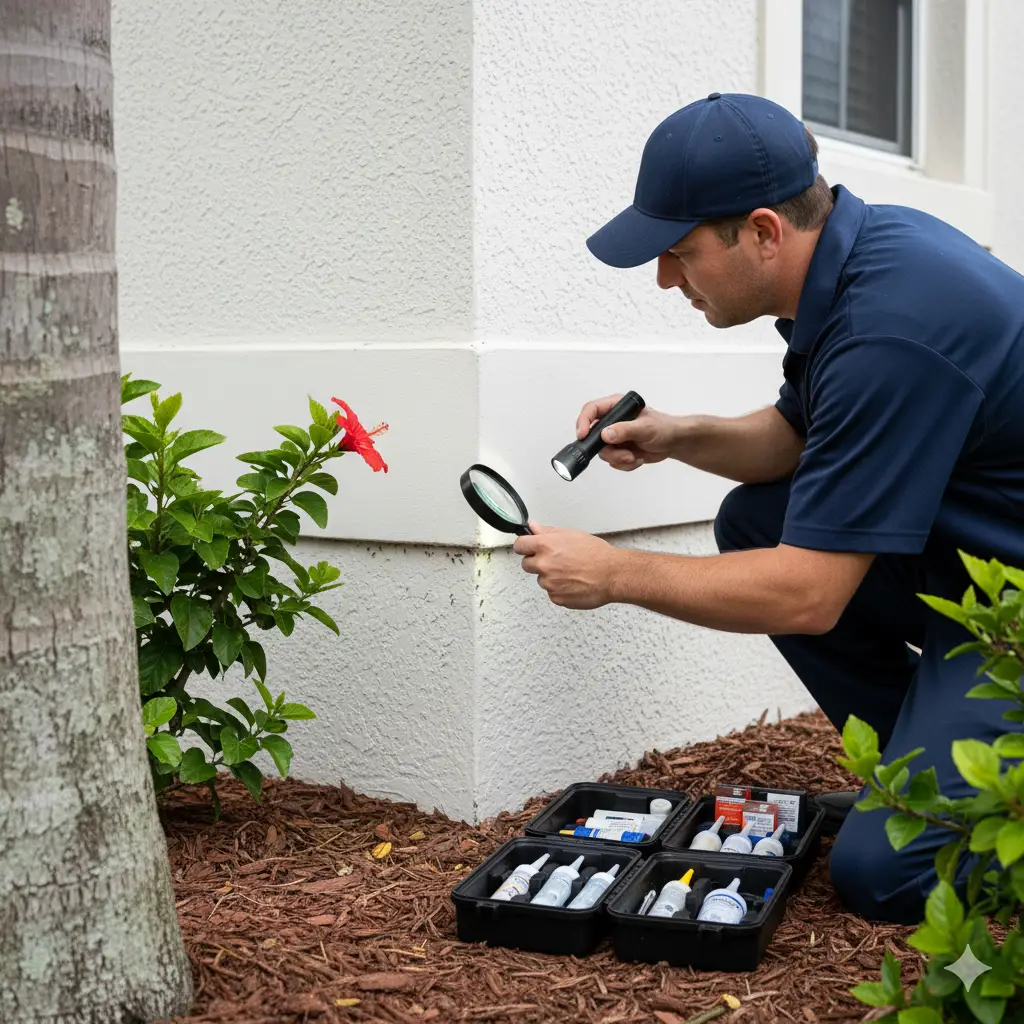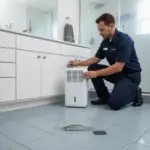Why White-Footed Ants Are South Florida’s Most Persistent Pest—And How to Eliminate Them
If you’re battling a persistent trail of small, dark ants inside your South Florida home that seem completely unfazed by your efforts, you’re likely dealing with white-footed ants. For homeowners in Miami-Dade and Broward County, these ants are a special kind of frustration. They don’t respond to common ant baits or sprays, and their colonies can number in the millions. At NaturePest, we understand the unique challenge they present. Standard pest control methods fail because white-footed ants require a specialized, strategic approach. This guide will explain exactly why they are so difficult to control and outline the proven, holistic strategy we use to successfully eradicate them from South Florida properties.
What Makes White-Footed Ants Different from Other Ants in Florida?
White-footed ants (Technomyrmex difficilis) are an invasive species that have become a dominant pest in South Florida. They are small, dark brown to black ants with pale yellow-white feet (tarsi). What sets them apart is not their appearance, but their social structure and biology. Unlike most ants that have a single queen, white-footed ants form massive “supercolonies” with hundreds of queens and millions of workers spread across multiple, interconnected nests in trees, mulch, and wall voids.
The Supercolony Challenge: Why Standard Treatments Fail
This supercolony structure is the core reason for treatment failure. When you kill a section of the colony with a repellent spray or the wrong type of bait, the supercolony simply redistributes its resources. The surviving queens continue to reproduce, and the ants often just avoid the treated area, reappearing elsewhere in your home. As experts from the University of Florida’s Institute of Food and Agricultural Sciences (UF/IFAS) state, “Control of white-footed ants is difficult… they have multiple queens and can form supercolonies. Patience and the use of non-repellent baits are essential.”
The Biology of a White-Footed Ant Infestation in South Florida
Understanding their behavior is the first step to elimination. White-footed ants are attracted to sweet substances (honeydew from insects like aphids on plants) and proteins. They are highly dependent on water, which is why infestations often intensify during South Florida’s rainy season or near irrigation systems. They typically nest outdoors in trees, stumps, and mulch beds but will forage indoors for food and water, creating long, persistent trails along utility lines and tree branches that touch the house.
Understanding Their Feeding Patterns and Nesting Habits
Their foraging behavior is predictable but extensive. They establish well-defined trails from their nests to food sources. A key aspect of our holistic ant control service involves tracing these trails back to their source, which is often not a single nest but a network of nests.
Why DIY Methods Almost Always Fail Against White-Footed Ants
Most store-bought solutions are designed for common ants like sugar-loving Argentine ants or grease-eating carpenter ants. Using these on white-footed ants is ineffective and often counterproductive.
The Critical Mistake: Using Repellent Sprays
Spraying ants you see indoors with a repellent insecticide is the most common mistake. This doesn’t kill the colony; it just breaks the trail temporarily. The supercolony detects the repellent and simply finds a new route into your home, often making the problem appear in new, previously unaffected areas. It fractures the problem without solving it.
The NaturePest Holistic Eradication Strategy: A Multi-Phase Approach
Our method is based on patience, precision, and using the ants’ own biology against them. We avoid broad-spectrum sprays that harm the ecosystem and focus on targeted, intelligent solutions.
Phase 1: Inspection and Mapping the Supercolony
Our first step is a thorough inspection to identify foraging trails, nesting sites (both indoors and outdoors), and the extent of the supercolony. We look for aphid-infested plants that may be providing a food source and identify moisture issues that are attracting them.
Phase 2: Strategic Baiting with Protein-Based Solutions
This is the most critical phase. White-footed ants have a strong preference for protein, especially during certain times of the year. We use specially formulated, non-repellent protein baits. The foraging ants take this bait back to the nest and share it with the queens, nurses, and other workers. This slow-acting process ensures the bait reaches the heart of the supercolony, effectively eliminating it from the inside out. This requires multiple service visits over several weeks.
Phase 3: Exclusion and Habitat Modification
Once the colony is under control, we work with you to make your property less attractive. This includes:
- Trimming Vegetation: Cutting back tree branches and shrubs that touch the house to eliminate ant highways.
- Sealing Entry Points: Caulking cracks and gaps around windows, doors, and utility penetrations.
- Addressing Moisture: Fixing leaky faucets and improving drainage to reduce water sources.
- Managing Honeydew Producers: Treating plants for aphids and other honeydew-producing insects.
For ongoing protection, especially for properties with heavy landscaping, our residential pest control plans provide continuous monitoring and prevention.
Preventing White-Footed Ant Reinfestations in South Florida
Prevention is about creating a hostile environment for supercolonies.
- Maintain a Dry Perimeter: Ensure gutters are clean and downspouts direct water away from the foundation.
- Use Gravel Instead of Mulch: Create a 12-inch gravel border around the foundation to discourage nesting.
- Store Food Securely: Keep pet food and other protein sources in sealed containers.
- Regular Monitoring: Keep an eye out for new ant activity, especially after heavy rains.
White-Footed Ant Control: DIY vs. Professional Service
| Feature | DIY Methods | NaturePest Professional Service |
|---|---|---|
| Effectiveness | Very low; often makes the problem worse | High; strategic, multi-phase approach targets the entire supercolony |
| Cost | Low upfront cost | Investment in a guaranteed, permanent solution |
| Safety | Varies; chemicals can be hazardous to pets and kids | Family-safe, pet-safe, and eco-friendly targeted baits |
| Time & Effort | High; ongoing, frustrating, and ineffective | We manage the entire process over several weeks for complete eradication |
| Guarantee | None | Service guarantee; we stay on the case until the problem is resolved |
| Ideal For | Minor, unconfirmed ant problems | Confirmed white-footed ant infestations and supercolony eradication |
Frequently Asked Questions About White-Footed Ants
Q1: Are white-footed ants dangerous? Do they cause damage? A: White-footed ants do not sting, bite, or cause structural damage like carpenter ants. Their primary nuisance is their massive numbers and persistent invasions into homes. They can contaminate food and are generally considered a significant household pest due to their difficulty to control.
Q2: I’ve used ant baits from the store with no success. Why? A: Most store-bought baits are designed for sugar-feeding ants. White-footed ants have a strong preference for protein. Using the wrong type of bait, or using a repellent bait that the ants avoid, will have no effect on the supercolony. Effective baiting requires the correct attractant and a non-repellent formula.
Q3: How long does it take to get rid of white-footed ants? A: Due to their supercolony structure, eradication is not immediate. A successful professional treatment program can take 4 to 8 weeks. The goal is to ensure the bait is circulated throughout the entire colony network to kill the queens. Patience is key.
Q4: Can I ever fully get rid of them, or will they just come back? A: With a professional, strategic baiting program and proper exclusion work, you can achieve complete eradication on your property. However, because they are prevalent in the South Florida environment, reinfestation from neighboring properties is possible. This is why ongoing preventive pest control is highly recommended for long-term peace of mind.
Don’t let white-footed ants outsmart you. If you’re tired of temporary fixes, it’s time for a strategic solution. Let NaturePest’s ant specialists develop a customized eradication plan for your South Florida home. Contact us today for a thorough inspection or call us at 786-222-7069.



